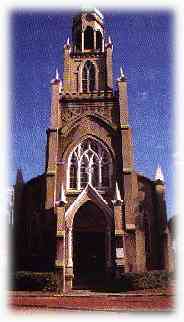|
|

|
|
|

|
Jewish World Review Oct. 1, 1998 /11 Tishrei, 5759
The Tale of the Gothic synagogue
Or: When the majority of
ONE OF THE INDELIBLE IMPRESSIONS you get upon visting Savannah, Georgia is that you are visiting a heimish part of America. Where else can you wander around the picturesque historic streets and come across a bronze historical marker that says: "This century home built in 1850 by Samuel Cohen"?
Jews were an integral part of Savannah from its very foundation. The second boatload of colonists to land in Georgia, five months after James Ogelthorpe's original English settlers, was a group of 42 Jewish settlers who arrived on July 11, 1773, on a ship chartered by London's Sephardic synagogue.
The Jewish colonists thrived and in a few years numbered over 100 souls. For a period in the late 1740s, they were actually the majority settlers in the Georgia Colony. In 1742, however, war broke out between Spain and England and Spanish forces landed on St. Simons Island, some 70 miles south of Savannah.
The Savannah Sephardic community was terrified of the Spaniards. Despite their British citizenship, these Jews were descendants of Spanish Marranos who fled the Spanish Inquisition and they feared their oppressors' heavy hands had now reached to America.
Fearing for their lives if Savannah fell to the Spaniards, Georgia's Sephardic community fled to Charleston, South Carolina and other points further north.
The Sheftell and other Ashkenazic (Eastern-European) families, however, remained in Savannah since they felt that they would not be tried as apostates by the Spanish. This was never put to the test. The Spanish never made it past St. Simons Island, and the Sephardic Jews slowly returned to Savannah.
When English architect Henry Harrison was asked by the Savannah congregation to design a house of worship for them, he had no experience building synagogues, but had built many Gothic churches. Mickve Israel, America's oldest congregation practising Reform Judaism, thus ended up in a stucture reminiscent of a European cathedral.
The temple is now a national landmark and adjacent to it is a museum containing artifacts brought from England by the original colonists and letters to the congregation from seven presidents, including a flowery greeting from George Washington.
Among the poignant pieces of Judaica on display is a magnificient megilas Esther, the scroll read on the Jewish festival of Purim, which was brought from Europe. When I asked the guide if the scroll is ever used on Purim, she answered somewhat wistfully that being Reform, the congregation no longer observes Purim.
Savannah today has a vibrant Jewish community numbering in the thousands. In addition to Mickve Israel, there is a large Orthodox congregation, Bnai Brith Jacob, on Abercorn St., and a Conservative congregation, Agudath Achim, on Lee Blv. Savannah also has an impressive Jewish Community Center and sports complex. Its kosher bakery, Gottlieb's, is known throughout the South.
The third oldest Jewish community in America continues to
Savannah Diarist
Congregation Mickve Israel
is a National Historic Landmark
Georgia was Jewish
By Herb Geduld
FIRST CONGREGATION
Kehillat Kodesh Mickve Israel was organized in 1735 and a ritualarium was built is 1738. Services were conducted in members' homes until 1820, when the first synagogue was built at Liberty and Whitaker streets, in the center of the historic district. The building was destroyed by a fire in 1829 and was eventually replaced by the impressive 14th Century Gothic structure on Monterrey Square, which still houses the congregation.
Jewish historian, cultural maven, and JWR contributor Herb Geduld lives in Cleveland.

6/98:
Charlie Levine and
his flying machine
4/98: We nearly had a planet named 'Herschel'
3/98: FLASH! How two nice Jewish musicians created color film
2/16/98: Isachar Zacharie, Presidential Corn-cutter and confidant
2/3/98: When Monticello had a mezuzah